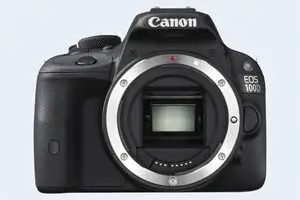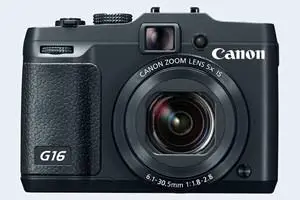Canon 100D vs G16
The Canon EOS 100D (called Canon SL1 in some regions) and the Canon PowerShot G16 are two digital cameras that were announced, respectively, in March 2013 and August 2013. The 100D is a DSLR, while the G16 is a fixed lens compact. The cameras are based on an APS-C (100D) and a 1/1.7-inch (G16) sensor. The 100D has a resolution of 17.9 megapixels, whereas the G16 provides 12 MP.
Below is an overview of the main specs of the two cameras as a starting point for the comparison.

Check 100D offers at
ebay.com

Check G16 offers at
ebay.com
Going beyond this snapshot of core features and characteristics, what are the differences between the Canon EOS 100D and the Canon PowerShot G16? Which one should you buy? Read on to find out how these two cameras compare with respect to their body size, their imaging sensors, their shooting features, their input-output connections, and their reception by expert reviewers.
Body comparison
The physical size and weight of the Canon 100D and the Canon G16 are illustrated in the side-by-side display below. The two cameras are presented according to their relative size. Three consecutive views from the front, the top, and the rear side are shown. All size dimensions are rounded to the nearest millimeter.
The 100D can be obtained in two different colors (black, white), while the G16 is only available in black.
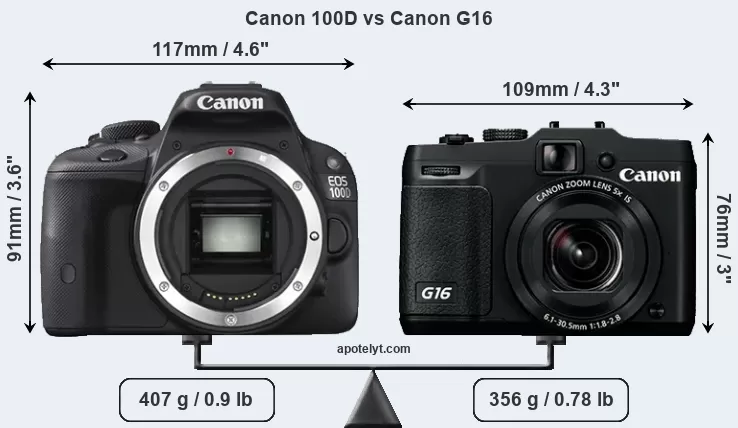
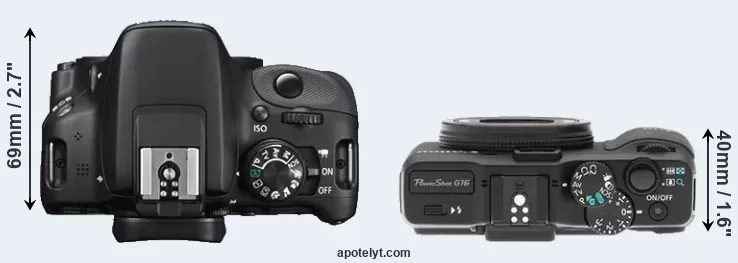
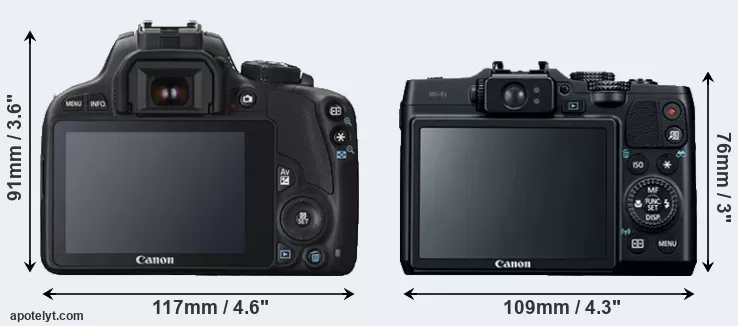
If the front view area (width x height) of the cameras is taken as an aggregate measure of their size, the Canon G16 is notably smaller (22 percent) than the Canon 100D. In this context, it is worth noting that neither the 100D nor the G16 are weather-sealed.
The above size and weight comparisons are to some extent incomplete and possibly misleading, as the G16 has a lens built in, whereas the 100D is an interchangeable lens camera that requires a separate lens. Attaching the latter will add extra weight and bulk to the setup. You can compare the optics available for the 100D and their specifications in the Canon EF Lens Catalog.
Concerning battery life, the 100D gets 380 shots out of its Canon LP-E12 battery, while the G16 can take 360 images on a single charge of its Canon NB-10L power pack.
The adjacent table lists the principal physical characteristics of the two cameras alongside a wider set of alternatives. In case you want to display and compare another camera duo, you can use the CAM-parator app to select your camera combination among a large number of options.

| # | Camera Model |
Camera Width |
Camera Height |
Camera Depth |
Camera Weight |
Battery Life |
Weather Sealing |
Camera Launch |
Launch Price (USD) |
Street Price |
|
|---|---|---|---|---|---|---|---|---|---|---|---|
| 1. | Canon 100D | 117 mm | 91 mm | 69 mm | 407 g | 380 | n | Mar 2013 | 549 | ebay.com | |
| 2. | Canon G16 | 109 mm | 76 mm | 40 mm | 356 g | 360 | n | Aug 2013 | 549 | ebay.com | |
| 3. | Canon 4000D | 129 mm | 102 mm | 77 mm | 436 g | 500 | n | Feb 2018 | 399 | amazon.com | |
| 4. | Canon 200D | 122 mm | 93 mm | 70 mm | 453 g | 650 | n | Jun 2017 | 549 | ebay.com | |
| 5. | Canon 1300D | 129 mm | 101 mm | 78 mm | 485 g | 500 | n | Mar 2016 | 449 | ebay.com | |
| 6. | Canon 1200D | 130 mm | 100 mm | 78 mm | 480 g | 500 | n | Feb 2014 | 449 | ebay.com | |
| 7. | Canon 700D | 133 mm | 100 mm | 79 mm | 580 g | 440 | n | Mar 2013 | 649 | ebay.com | |
| 8. | Canon SL1 | 117 mm | 91 mm | 69 mm | 407 g | 380 | n | Mar 2013 | 549 | ebay.com | |
| 9. | Canon 650D | 133 mm | 100 mm | 79 mm | 575 g | 440 | n | Jun 2012 | 849 | ebay.com | |
| 10. | Canon G15 | 107 mm | 76 mm | 40 mm | 352 g | 350 | n | Sep 2012 | 499 | ebay.com | |
| 11. | Canon M | 109 mm | 66 mm | 32 mm | 298 g | 230 | n | Jul 2012 | 599 | ebay.com | |
| 12. | Canon 600D | 133 mm | 100 mm | 80 mm | 570 g | 440 | n | Feb 2011 | 599 | ebay.com | |
| 13. | Canon G12 | 112 mm | 76 mm | 48 mm | 401 g | 370 | n | Sep 2010 | 499 | ebay.com | |
| 14. | Nikon P7800 | 119 mm | 78 mm | 50 mm | 399 g | 350 | n | Sep 2013 | 549 | ebay.com | |
| 15. | Panasonic G6 | 122 mm | 85 mm | 71 mm | 390 g | 340 | n | Apr 2013 | 599 | ebay.com | |
| 16. | Panasonic LX7 | 111 mm | 68 mm | 46 mm | 298 g | 330 | n | Jul 2012 | 499 | ebay.com | |
| Note: Measurements and pricing do not include easily detachable parts, such as add-on or interchangeable lenses or optional viewfinders. | |||||||||||
Any camera decision will naturally be influenced heavily by the price. The retail prices at the time of the camera’s release place the model in the market relative to other models in the producer’s line-up and the competition. Usually, retail prices stay at first close to the launch price, but after several months, discounts become available. Later in the product cycle and, in particular, when the replacement model is about to appear, further discounting and stock clearance sales often push the camera price considerably down.
Sensor comparison
The imaging sensor is at the core of digital cameras and its size is one of the main determining factors of image quality. A large sensor will generally have larger individual pixels that offer better low-light sensitivity, provide wider dynamic range, and have richer color-depth than smaller pixels in a sensor of the same technological generation. Moreover, a large sensor camera will give the photographer more control over depth-of-field in the image and, thus, the ability to better isolate a subject from the background. On the downside, larger sensors tend to be more expensive and lead to bigger and heavier cameras and lenses.
Of the two cameras under consideration, the Canon 100D features an APS-C sensor and the Canon G16 a 1/1.7-inch sensor. The sensor area in the G16 is 87 percent smaller. As a result of these sensor size differences, the cameras have a format factor of, respectively, 1.6 and 4.65. The sensor in the 100D has a native 3:2 aspect ratio, while the one in the G16 offers a 4:3 aspect.
Technology-wise, the G16 uses a more advanced image processing engine (DIGIC 6) than the 100D (DIGIC 5), with benefits for noise reduction, color accuracy, and processing speed.
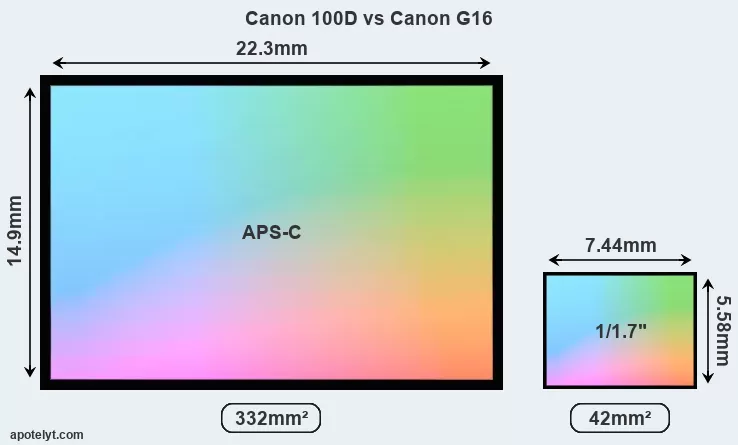
With 17.9MP, the 100D offers a higher resolution than the G16 (12MP), but the 100D nevertheless has larger individual pixels (pixel pitch of 4.31μm versus 1.87μm for the G16) due to its larger sensor. However, the G16 is a somewhat more recent model (by 5 months) than the 100D, and its sensor might have benefitted from technological advances during this time that enhance the light gathering capacity of its pixels.
The resolution advantage of the Canon 100D implies greater flexibility for cropping images or the possibility to print larger pictures. The maximum print size of the 100D for good quality output (200 dots per inch) amounts to 25.9 x 17.3 inches or 65.8 x 43.9 cm, for very good quality (250 dpi) 20.7 x 13.8 inches or 52.7 x 35.1 cm, and for excellent quality (300 dpi) 17.3 x 11.5 inches or 43.9 x 29.3 cm. The corresponding values for the Canon G16 are 20 x 15 inches or 50.8 x 38.1 cm for good quality, 16 x 12 inches or 40.6 x 30.5 cm for very good quality, and 13.3 x 10 inches or 33.9 x 25.4 cm for excellent quality prints.
The 100D has on-sensor phase detect pixels, which results in fast and reliable autofocus acquisition even during live view operation.
The Canon EOS 100D has a native sensitivity range from ISO 100 to ISO 12800, which can be extended to ISO 100-25600. The corresponding ISO settings for the Canon PowerShot G16 are ISO 80 to ISO 12800 (no boost).
In terms of underlying technology, the 100D is build around a CMOS sensor, while the G16 uses a BSI-CMOS imager. Both cameras use a Bayer filter for capturing RGB colors on a square grid of photosensors. This arrangement is found in most digital cameras.
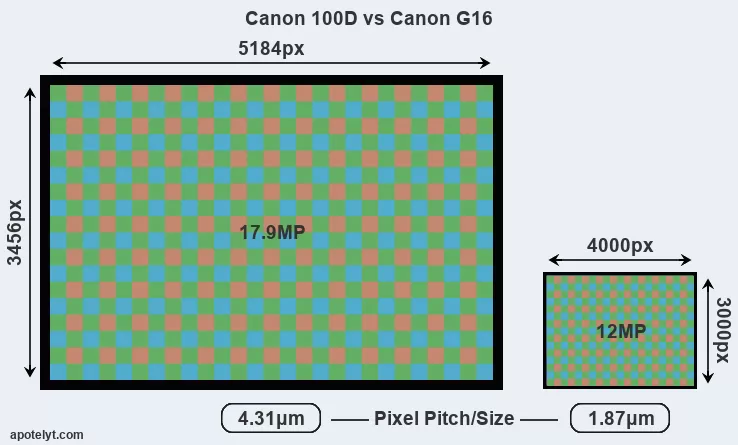
Consistent information on actual sensor performance is available from DXO Mark for many cameras. This service assesses and scores the color depth ("DXO Portrait"), dynamic range ("DXO Landscape"), and low-light sensitivity ("DXO Sports") of camera sensors, and also publishes an overall camera score. Of the two cameras under review, the 100D has a notably higher overall DXO score than the G16 (overall score 9 points higher), which gives it an advantage in terms of imaging quality. This advantage is based on 0.8 bits higher color depth, 0.4 EV of lower dynamic range, and 1.9 stops in additional low light sensitivity. The table below summarizes the physical sensor characteristics and sensor quality findings and compares them across a set of similar cameras.

| # | Camera Model |
Sensor Class |
Resolution (MP) |
Horiz. Pixels |
Vert. Pixels |
Video Format |
DXO Portrait |
DXO Landscape |
DXO Sports |
DXO Overall |
|
|---|---|---|---|---|---|---|---|---|---|---|---|
| 1. | Canon 100D | APS-C | 17.9 | 5184 | 3456 | 1080/30p | 21.8 | 11.3 | 843 | 63 | |
| 2. | Canon G16 | 1/1.7 | 12.0 | 4000 | 3000 | 1080/60p | 21.0 | 11.7 | 230 | 54 | |
| 3. | Canon 4000D | APS-C | 17.9 | 5184 | 3456 | 1080/30p | 21.9 | 11.4 | 695 | 63 | |
| 4. | Canon 200D | APS-C | 24.0 | 6000 | 4000 | 1080/60p | 23.6 | 13.4 | 1041 | 79 | |
| 5. | Canon 1300D | APS-C | 17.9 | 5184 | 3456 | 1080/30p | 22.0 | 11.7 | 781 | 66 | |
| 6. | Canon 1200D | APS-C | 17.9 | 5184 | 3456 | 1080/30p | 21.9 | 11.3 | 724 | 63 | |
| 7. | Canon 700D | APS-C | 17.9 | 5184 | 3456 | 1080/30p | 21.7 | 11.2 | 681 | 61 | |
| 8. | Canon SL1 | APS-C | 17.9 | 5184 | 3456 | 1080/30p | 21.8 | 11.3 | 843 | 63 | |
| 9. | Canon 650D | APS-C | 17.9 | 5184 | 3456 | 1080/30p | 21.7 | 11.2 | 722 | 62 | |
| 10. | Canon G15 | 1/1.7 | 12.0 | 4000 | 3000 | 1080/24p | 19.9 | 11.5 | 165 | 46 | |
| 11. | Canon M | APS-C | 17.9 | 5184 | 3456 | 1080/30p | 22.1 | 11.2 | 827 | 65 | |
| 12. | Canon 600D | APS-C | 17.9 | 5184 | 3456 | 1080/30p | 22.1 | 11.5 | 793 | 65 | |
| 13. | Canon G12 | 1/1.7 | 10.0 | 3648 | 2736 | 720/24p | 20.4 | 11.2 | 161 | 47 | |
| 14. | Nikon P7800 | 1/1.7 | 12.0 | 4000 | 3000 | 1080/30p | 21.2 | 11.7 | 200 | 54 | |
| 15. | Panasonic G6 | Four Thirds | 15.9 | 4608 | 3456 | 1080/60p | 21.3 | 11.5 | 639 | 61 | |
| 16. | Panasonic LX7 | 1/1.7 | 10.0 | 3648 | 2736 | 1080/60p | 20.7 | 11.7 | 147 | 50 |
Many modern cameras are not only capable of taking still images, but also of capturing video footage. Both cameras under consideration have a sensor with sufficiently fast read-out times for moving pictures, but the G16 provides a faster frame rate than the 100D. It can shoot movie footage at 1080/60p, while the 100D is limited to 1080/30p.
Feature comparison
Apart from body and sensor, cameras can and do differ across a variety of features. The 100D and the G16 are similar in the sense that both have an optical viewfinder. The latter is useful for getting a clear image for framing even in brightly lit environments. The table below summarizes some of the other core capabilities of the Canon 100D and Canon G16 in connection with corresponding information for a sample of similar cameras.

| # | Camera Model |
Viewfinder (Type or 000 dots) |
Control Panel (yes/no) |
LCD Specifications (inch/000 dots) |
LCD Attach- ment |
Touch Screen (yes/no) |
Max Shutter Speed * |
Max Shutter Flaps * |
Built-in Flash (yes/no) |
Built-in Image Stab |
|
|---|---|---|---|---|---|---|---|---|---|---|---|
| 1. | Canon 100D | optical | n | 3.0 / 1040 | fixed | Y | 1/4000s | 4.9/s | Y | n | |
| 2. | Canon G16 | optical | n | 3.0 / 922 | fixed | n | 1/4000s | 2.2/s | Y | Y | |
| 3. | Canon 4000D | optical | n | 2.7 / 230 | fixed | n | 1/4000s | 3.0/s | Y | n | |
| 4. | Canon 200D | optical | n | 3.0 / 1040 | swivel | Y | 1/4000s | 5.0/s | Y | n | |
| 5. | Canon 1300D | optical | n | 3.0 / 920 | fixed | n | 1/4000s | 3.0/s | Y | n | |
| 6. | Canon 1200D | optical | n | 3.0 / 460 | fixed | n | 1/4000s | 3.0/s | Y | n | |
| 7. | Canon 700D | optical | n | 3.0 / 1040 | swivel | Y | 1/4000s | 5.0/s | Y | n | |
| 8. | Canon SL1 | optical | n | 3.0 / 1040 | fixed | Y | 1/4000s | 4.9/s | Y | n | |
| 9. | Canon 650D | optical | n | 3.0 / 1040 | swivel | Y | 1/4000s | 5.0/s | Y | n | |
| 10. | Canon G15 | optical | n | 3.0 / 922 | fixed | n | 1/4000s | 2.1/s | Y | Y | |
| 11. | Canon M | none | n | 3.0 / 1040 | fixed | Y | 1/4000s | 4.3/s | n | n | |
| 12. | Canon 600D | optical | n | 3.0 / 1040 | swivel | n | 1/4000s | 3.7/s | Y | n | |
| 13. | Canon G12 | optical | n | 2.8 / 461 | swivel | n | 1/4000s | 1.1/s | Y | Y | |
| 14. | Nikon P7800 | 921 | n | 3.0 / 921 | swivel | n | 1/4000s | 8.0/s | Y | Y | |
| 15. | Panasonic G6 | 1440 | n | 3.0 / 1036 | swivel | Y | 1/4000s | 7.0/s | Y | n | |
| 16. | Panasonic LX7 | optional | n | 3.0 / 920 | fixed | n | 1/4000s | 11.0/s | Y | Y | |
| Note: *) Information refers to the mechanical shutter, unless the camera only has an electronic one. | |||||||||||
One differentiating feature between the two cameras concerns the touch sensitivity of the rear screen. The 100D has a touchscreen, while the G16 has a conventional panel. Touch control can be particularly helpful, for example, for setting the focus point.
The Canon G16 has an intervalometer built-in. This enables the photographer to capture time lapse sequences, such as flower blooming, a sunset or moon rise, without purchasing an external camera trigger and related software.
Concerning the storage of imaging data, both the 100D and the G16 write their files to SDXC cards. Both cameras can use UHS-I cards, which provide for Ultra High Speed data transfer of up to 104 MB/s.
Connectivity comparison
For some imaging applications, the extent to which a camera can communicate with its environment can be an important aspect in the camera decision process. The table below provides an overview of the connectivity of the Canon EOS 100D and Canon PowerShot G16 and, in particular, the interfaces the cameras (and selected comparators) provide for accessory control and data transfer.

| # | Camera Model |
Hotshoe Port |
Internal Mic / Speaker |
Microphone Port |
Headphone Port |
HDMI Port |
USB Port |
WiFi Support |
NFC Support |
Bluetooth Support |
|
|---|---|---|---|---|---|---|---|---|---|---|---|
| 1. | Canon 100D | Y | mono / mono | Y | - | mini | 2.0 | - | - | - | |
| 2. | Canon G16 | Y | stereo / mono | - | - | mini | 2.0 | Y | - | - | |
| 3. | Canon 4000D | Y | mono / mono | - | - | mini | 2.0 | Y | Y | - | |
| 4. | Canon 200D | Y | stereo / mono | Y | - | mini | 2.0 | Y | Y | Y | |
| 5. | Canon 1300D | Y | mono / mono | - | - | mini | 2.0 | Y | Y | - | |
| 6. | Canon 1200D | Y | mono / mono | - | - | mini | 2.0 | - | - | - | |
| 7. | Canon 700D | Y | stereo / mono | Y | - | mini | 2.0 | - | - | - | |
| 8. | Canon SL1 | Y | mono / mono | Y | - | mini | 2.0 | - | - | - | |
| 9. | Canon 650D | Y | stereo / mono | Y | - | mini | 2.0 | - | - | - | |
| 10. | Canon G15 | Y | stereo / mono | - | - | mini | 2.0 | - | - | - | |
| 11. | Canon M | Y | stereo / mono | Y | - | mini | 2.0 | - | - | - | |
| 12. | Canon 600D | Y | mono / mono | Y | - | mini | 2.0 | - | - | - | |
| 13. | Canon G12 | Y | stereo / mono | - | - | mini | 2.0 | - | - | - | |
| 14. | Nikon P7800 | Y | stereo / mono | Y | - | mini | 2.0 | - | - | - | |
| 15. | Panasonic G6 | Y | stereo / mono | Y | - | mini | 2.0 | Y | Y | - | |
| 16. | Panasonic LX7 | Y | stereo / mono | - | - | mini | 2.0 | - | - | - |
It is notable that the 100D has a microphone port, which is missing on the G16. Such an external microphone input can help to substantially improve the quality of audio recordings when a good external microphone is used.
Both the 100D and the G16 have been discontinued, but can regularly be found used on ebay. The 100D was replaced by the Canon 200D, while the G16 does not have a direct successor. Further information on the features and operation of the 100D and G16 can be found, respectively, in the Canon 100D Manual (free pdf) or the online Canon G16 Manual.
Review summary
So what is the bottom line? Which of the two cameras – the Canon 100D or the Canon G16 – has the upper hand? Is one clearly better than the other? Below is a summary of the relative strengths of each of the two contestants.
Advantages of the Canon EOS 100D:
- More detail: Offers more megapixels (17.9 vs 12MP) with a 25% higher linear resolution.
- Better image quality: Scores markedly higher (9 points) in the DXO overall assessment.
- Better low-light sensitivity: Requires less light for good images (1.9 stops ISO advantage).
- Better live-view autofocus: Features on-sensor phase-detection for more confident autofocus.
- Better sound: Can connect to an external microphone for higher quality sound recording.
- More detailed LCD: Has a higher resolution rear screen (1040k vs 922k dots).
- Fewer buttons to press: Is equipped with a touch-sensitive rear screen to facilitate handling.
- Faster burst: Shoots at higher frequency (4.9 vs 2.2 flaps/sec) to capture the decisive moment.
- More flexible: Can take a variety of interchangeable lenses, including specialty optics.
- More heavily discounted: Has been on the market for longer (launched in March 2013).
Reasons to prefer the Canon PowerShot G16:
- Better jpgs: Has a more modern image processing engine (DIGIC 6 vs DIGIC 5).
- Better video: Provides higher movie framerates (1080/60p versus 1080/30p).
- Easier time-lapse photography: Has an intervalometer built-in for low frequency shooting.
- Ready to shoot: Comes with an integrated lens, while the 100D requires a separate lens.
- More compact: Is smaller (109x76mm vs 117x91mm) and will fit more readily into a bag.
- Less heavy: Has a lower weight even though it has a lens built in (unlike the 100D).
- Sharper images: Has stabilization technology built-in to reduce the impact of hand-shake.
- Easier file upload: Has wifi built in for automatic backup or image transfer to the web.
- More modern: Was introduced somewhat (5 months) more recently.
If the count of individual advantages (bullet points above) is taken as a guide, the 100D comes out slightly ahead of the G16 (10 : 9 points). However, the relative importance of the various individual camera aspects will vary according to personal preferences and needs, so that you might like to apply corresponding weights to the particular features before making a decision on a new camera. A professional sports photographer will view the differences between cameras in a way that diverges from the perspective of a street photog, and a person interested in family portraits has distinct needs from a landscape shooter. Hence, the decision which camera is best and worth buying is often a very personal one.
How about other alternatives? Do the specifications of the Canon 100D and the Canon G16 place the cameras among the top in their class? Find out in the latest Best DSLR Camera and Best Travel-Zoom Camera listings whether the two cameras rank among the cream of the crop.
In any case, while the comparison of technical specifications can provide a useful overview of the capabilities of different cameras, it remains partial and cannot reveal, for example, the shooting experience and imaging performance when actually working with the 100D or the G16. User reviews, such as those found at amazon, can sometimes inform about these issues, but such feedback is often incomplete, inconsistent, and biased.
Expert reviews
This is why expert reviews are important. The following table reports the overall ratings of the cameras as published by some of the major camera review sites (amateurphotographer [AP], cameralabs [CL], digitalcameraworld [DCW], dpreview [DPR], ephotozine [EPZ], photographyblog [PB]). As can be seen, the professional reviewers agree in many cases on the quality of different cameras, but sometimes their assessments diverge, reinforcing the earlier point that a camera decision is often a very personal choice.

| # | Camera Model |
AP score |
CL score |
DCW score |
DPR score |
EPZ score |
PB score |
Camera Launch |
Launch Price (USD) |
Street Price |
|
|---|---|---|---|---|---|---|---|---|---|---|---|
| 1. | Canon 100D | 4/5 | + | .. | 78/100 | 4/5 | 4/5 | Mar 2013 | 549 | ebay.com | |
| 2. | Canon G16 | 4/5 | + | .. | .. | 4.5/5 | 4.5/5 | Aug 2013 | 549 | ebay.com | |
| 3. | Canon 4000D | 2.5/5 | o | 3/5 | .. | 3.5/5 | 3.5/5 | Feb 2018 | 399 | amazon.com | |
| 4. | Canon 200D | 4/5 | + + | 4/5 | 78/100 | 4.5/5 | 4.5/5 | Jun 2017 | 549 | ebay.com | |
| 5. | Canon 1300D | 4/5 | o | 4/5 | 73/100 | 4/5 | 4/5 | Mar 2016 | 449 | ebay.com | |
| 6. | Canon 1200D | 3/5 | + | .. | .. | 4/5 | 4.5/5 | Feb 2014 | 449 | ebay.com | |
| 7. | Canon 700D | .. | .. | .. | 76/100 | 4.5/5 | 4.5/5 | Mar 2013 | 649 | ebay.com | |
| 8. | Canon SL1 | 4/5 | + | .. | 78/100 | 4/5 | 4/5 | Mar 2013 | 549 | ebay.com | |
| 9. | Canon 650D | 4/5 | + + | .. | 77/100 | 4.5/5 | 4.5/5 | Jun 2012 | 849 | ebay.com | |
| 10. | Canon G15 | 4/5 | + | .. | 76/100 | 4.5/5 | 4.5/5 | Sep 2012 | 499 | ebay.com | |
| 11. | Canon M | 3/5 | + | .. | .. | 4/5 | 4/5 | Jul 2012 | 599 | ebay.com | |
| 12. | Canon 600D | 3/5 | o | .. | 77/100 | 4.5/5 | 4.5/5 | Feb 2011 | 599 | ebay.com | |
| 13. | Canon G12 | 4/5 | + | .. | 73/100 | 4.5/5 | 4.5/5 | Sep 2010 | 499 | ebay.com | |
| 14. | Nikon P7800 | 3/5 | .. | .. | .. | 4/5 | 4.5/5 | Sep 2013 | 549 | ebay.com | |
| 15. | Panasonic G6 | 4/5 | + + | .. | .. | 5/5 | 4.5/5 | Apr 2013 | 599 | ebay.com | |
| 16. | Panasonic LX7 | 3/5 | + + | .. | 75/100 | 4/5 | 4.5/5 | Jul 2012 | 499 | ebay.com | |
| Note: (+ +) highly recommended; (+) recommended; (o) reviewed; (..) not available. | |||||||||||
The above review scores should be interpreted with care, though. The ratings were established in reference to similarly priced cameras that were available in the market at the time of the review. Hence, a score should always be seen in the context of the camera's market launch date and its price, and comparisons of ratings among very different cameras or across long time periods have little meaning. Also, please note that some of the review sites have changed their methodology and reporting over time.

Check 100D offers at
ebay.com

Check G16 offers at
ebay.com
Other camera comparisons
Did this review help to inform your camera decision process? In case you are interested in seeing how other cameras pair up, just make a corresponding selection in the search boxes below. There is also a set of direct links to comparison reviews that other users of the CAM-parator app explored.
- Canon 100D vs Canon 5D Mark III
- Canon 100D vs Canon SX420
- Canon 100D vs Leica V-LUX Typ 114
- Canon 100D vs Leica X Vario
- Canon 100D vs Olympus E-PL2
- Canon 100D vs Sony A7S II
- Canon 7D vs Canon G16
- Canon G16 vs Fujifilm XP130
- Canon G16 vs Leica M-E Typ 240
- Canon G16 vs Nikon D700
- Canon G16 vs Nikon D7100
- Canon G16 vs Pentax MX-1
Specifications: Canon 100D vs Canon G16
Below is a side-by-side comparison of the specs of the two cameras to facilitate a quick review of their differences and common features.
| Camera Model | Canon 100D | Canon G16 |
|---|---|---|
| Camera Type | Digital single lens reflex | Fixed lens compact camera |
| Camera Lens | Canon EF mount lenses | 28-140mm f/1.8-2.8 |
| Launch Date | March 2013 | August 2013 |
| Launch Price | USD 549 | USD 549 |
| Sensor Specs | Canon 100D | Canon G16 |
| Sensor Technology | CMOS | BSI-CMOS |
| Sensor Format | APS-C Sensor | 1/1.7" Sensor |
| Sensor Size | 22.3 x 14.9 mm | 7.44 x 5.58 mm |
| Sensor Area | 332.27 mm2 | 41.5152 mm2 |
| Sensor Diagonal | 26.8 mm | 9.3 mm |
| Crop Factor | 1.6x | 4.65x |
| Sensor Resolution | 17.9 Megapixels | 12 Megapixels |
| Image Resolution | 5184 x 3456 pixels | 4000 x 3000 pixels |
| Pixel Pitch | 4.31 μm | 1.87 μm |
| Pixel Density | 5.39 MP/cm2 | 28.91 MP/cm2 |
| Moiré control | Anti-Alias filter | Anti-Alias filter |
| Movie Capability | 1080/30p Video | 1080/60p Video |
| ISO Setting | 100 - 12,800 ISO | 80 - 12,800 ISO |
| ISO Boost | 100 - 25,600 ISO | no Enhancement |
| Image Processor | DIGIC 5 | DIGIC 6 |
| DXO Sensor Quality (score) | 63 | 54 |
| DXO Color Depth (bits) | 21.8 | 21.0 |
| DXO Dynamic Range (EV) | 11.3 | 11.7 |
| DXO Low Light (ISO) | 843 | 230 |
| Screen Specs | Canon 100D | Canon G16 |
| Viewfinder Type | Optical viewfinder | Optical viewfinder |
| Viewfinder Field of View | 95% | 80% |
| Viewfinder Magnification | 0.54x | |
| LCD Framing | Live View | Live View |
| Rear LCD Size | 3.0inch | 3.0inch |
| LCD Resolution | 1040k dots | 922k dots |
| LCD Attachment | Fixed screen | Fixed screen |
| Touch Input | Touchscreen | no Touchscreen |
| Shooting Specs | Canon 100D | Canon G16 |
| Focus System | Phase-detect AF | Contrast-detect AF |
| Manual Focusing Aid | no Peaking Feature | Focus Peaking |
| Max Shutter Speed (mechanical) | 1/4000s | 1/4000s |
| Continuous Shooting | 4.9 shutter flaps/s | 2.2 shutter flaps/s |
| Time-Lapse Photography | no Intervalometer | Intervalometer built-in |
| Fill Flash | Built-in Flash | Built-in Flash |
| Storage Medium | SDXC cards | SDXC cards |
| Single or Dual Card Slots | Single card slot | Single card slot |
| UHS card support | UHS-I | UHS-I |
| Connectivity Specs | Canon 100D | Canon G16 |
| External Flash | Hotshoe | Hotshoe |
| USB Connector | USB 2.0 | USB 2.0 |
| HDMI Port | mini HDMI | mini HDMI |
| Microphone Port | External MIC port | no MIC socket |
| Wifi Support | no Wifi | Wifi built-in |
| Body Specs | Canon 100D | Canon G16 |
| Battery Type | Canon LP-E12 | Canon NB-10L |
| Battery Life (CIPA) | 380 shots per charge | 360 shots per charge |
| Body Dimensions |
117 x 91 x 69 mm (4.6 x 3.6 x 2.7 in) |
109 x 76 x 40 mm (4.3 x 3.0 x 1.6 in) |
| Camera Weight | 407 g (14.4 oz) | 356 g (12.6 oz) |

Check 100D offers at
ebay.com

Check G16 offers at
ebay.com
Did you notice an error on this page? If so, please get in touch, so that we can correct the information.
